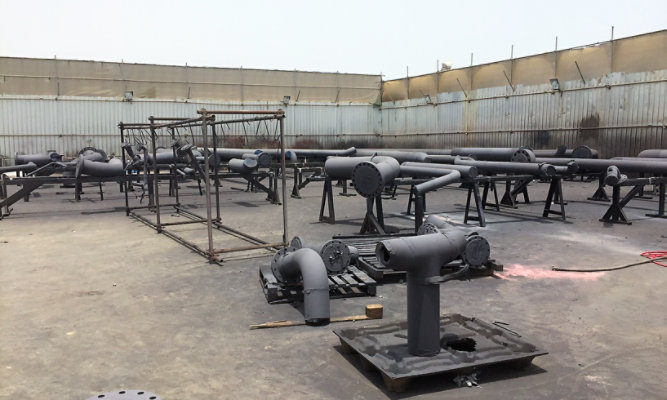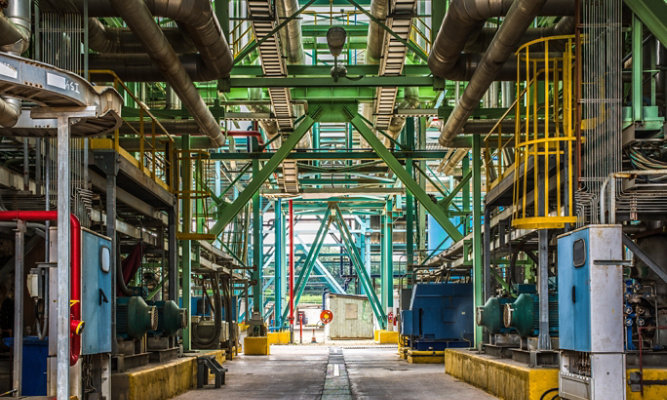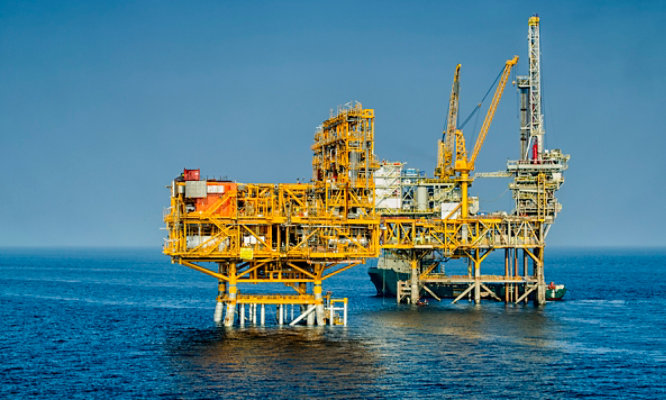Survey Says: On-Site Corrosion Assessments Drive Proactive Coatings Repairs, Maintenance Savings
Comprehensive site surveys for corrosion help oil and gas facilities enhance safety, maintain production and extend asset service lives
by John Hilton, Business Development Manager – Energy, Sherwin-Williams Protective & Marine

Performing proactive, preventive coatings maintenance is the best approach for keeping assets used in oil and gas facilities up and running. That means addressing noticeable coatings issues before they progress and scheduling inspections and restorations based on preplanned intervals. Doing so allows facilities to maintain appropriate corrosion protection that will help them extend asset lives and safeguard their bottom lines.
Of course, with scheduled proactive maintenance, facility owners run the risk of recoating an asset much earlier than needed. After all, coatings don’t necessarily deteriorate on a clockwork schedule – something you might expect to need restoration soon may last much longer, while something you thought could wait may need immediate attention.
So how do you know when the time is right to address a particular asset? And how do you know if that asset needs a simple coatings touchup, an intermediate overcoat or a complete restoration that takes it all the way down to bare steel before applying coatings? A wise approach is to let a certified corrosion specialist answer all of these questions. Better yet, ask that specialist to conduct a corrosion site survey that looks at more than just the asset in question. Then, you’ll know which of your assets are at risk, how soon you’ll need to address them and what coatings to use when you do.
Survey Priorities
The goal of a site corrosion survey is to determine the overall condition of coatings on a wide variety of assets so a facility can prioritize what needs to be addressed and when. Such assessments typically follow a priority order of their own, with surveyors and facility owners focusing on ensuring safety first, followed by maintaining production, extending asset service lives and addressing aesthetics.
Left unattended, a corrosion issue can turn into a safety issue. That’s why anything related to a potential safety risk is always a facility’s top priority. If corrosion or peeling paint are evident on a process vessel, the vessel may be at risk of developing a leak. Cracked coatings in a secondary containment area may enable spilled chemicals to breach the area and leach into the environment. Water or process fluids dripping from and pooling under insulation systems is a sure sign of corrosion under insulation (CUI), which will need to be inspected to ensure coatings or other repairs aren’t necessary. During a site survey, a certified corrosion specialist will look for and flag such deficiencies, assess their risk potential and recommend a plan for fixing them immediately.
Facility owners’ next concern is about ensuring uptime. Any asset that’s critical to production and revenue should get a close look during a site survey, as unplanned downtime can be costly. That means looking for cracked, blistered or peeled coatings, surface contamination and evidence of corrosion on production assets. The corrosion specialist performing the survey will look for anything that could potentially cause an asset to be taken offline for unplanned maintenance. The specialist will prioritize the most critical needs first and even suggest preventive maintenance plans to keep assets in their best operating condition.
Corrosion site surveys can also help facilities extend the service life of their assets. Beyond looking for noticeable areas of corrosion and coatings deficiencies, corrosion specialists will also look to predict future issues that could be mitigated by an early intervention. For example, they might suggest that a facility proactively overcoat a storage tank based on the premise that a less expensive overcoating today will prevent the need for completing a full tank coatings rehabilitation within a couple of years. The facility will save significant budget by opting for the simple, inexpensive intermediate repair, as the full restoration can then be delayed for several years. It may even be possible to overcoat the tank again in the future to further delay the full restoration.
Aesthetics are typically lowest on an oil and gas facility owner’s priority list, as the appearance of gloss and color are not typical concerns for down and dirty production assets. However, many facilities want public-facing areas to look their best. That may mean addressing assets located near the main building or next to a busy highway so the company is presenting itself in its best light. A corrosion specialist may point out such areas during a site survey and provide recommendations for enhancing aesthetics.
Conducting a Survey
During a comprehensive site survey, a corrosion specialist may walk through an entire plant with the facility’s maintenance team. However, corrosion site surveys more often cover smaller areas of a plant and are coordinated around the assessment of a particular asset. For example, a facility that’s ready to recoat its transformers may invite the specialist who will already be on-site to assess that repair to review surrounding assets such as utility structures, pylons and catwalks. This way, both parties can consider whether other complementary coatings work might be warranted now or in the future. Facility managers will likely point out assets of particular concern, but the corrosion specialist will be looking for anything else with a trained eye.
Most of a site survey is performed visually, with the corrosion specialist looking for visible signs of corrosion and any safety concerns. The specialist will pay close attention to areas that have contaminated surfaces and where water collects, as they’re ripe for corrosion potential. When spotting deficiencies, the specialist may also measure the thickness of existing coatings or even perform adhesion tests if warranted.
Any time is a good time for a corrosion site survey, but the wintertime can be especially advantageous since most coatings work can’t be done during especially cold months and winter weather. During this time, facility maintenance managers can focus on assessing needs and planning ahead so they’re ready when the weather breaks. As an example, a facility planning to address maintenance, repair and operations (MRO) work on a cooling tower unit over the next six months can work with a corrosion specialist to identify every area that needs to be recoated. The specialist may flag towers, vessels, heat exchangers, drums, secondary containment structures and any other area that needs attention. Then, the facility and corrosion specialist will have a few months to prioritize maintenance activities during the coating season, which may involve jamming as much coatings maintenance into a two-week plant shutdown as possible. Determining those priorities ahead of time – while also developing proactive repair specifications that identify the repair steps and preapproved coating solutions – will enable the facility to maximize its maintenance efforts during the shutdown.
Another proactive assessment approach is for the corrosion specialist to request a list of a facility’s tanks and review the dates of their latest coating and lining applications and their planned American Petroleum Institute (API) inspection schedules. If a tank that shows visible signs of exterior corrosion today is not due for an interior API lining inspection for another two years, for example, the corrosion specialist may suggest a lighter intermediate repair. That would involve overcoating the exterior corrosion today and then planning for a full rehabilitation when the tank comes offline for the interior inspection. Corrosion specialists may need to be on-site for the lining inspection anyway, so this approach allows the facility and coatings applicators to address the inside and outside of the tank at the same time.
Upon completion of a site survey, the corrosion specialist will prepare a comprehensive report that identifies any assets of concern and rates them in terms of their need for attention. This priority list will help the facility owner plan ahead for immediate and future maintenance and budget needs. Ideally, the report will include specification recommendations for the types of products for each repair, noting the approximate material and labor costs so the facility has a qualified reference when the time comes to request project bids.
Surveying the Results
In oil and gas production operations, there’s always something that needs to be maintained. It’s best to address that maintenance well before its needed so assets can remain online and don’t reach the point of requiring major repairs. However, there’s a sweet spot in that timing, as ultra-proactive maintenance may leave some valuable coating life on the table if a facility restores an asset too soon. The best way to spot areas of immediate concern – and know when it’s too soon to recoat – is by relying on a certified corrosion specialist to assess your facility’s assets. Proactive site surveys conducted by these coatings professionals will look for signs of corrosion and coatings deterioration. Thereafter, specialists can help facilities develop preventive maintenance plans that focus on safety, uptime and cost savings. Conducting such surveys on a frequent basis – even annually – is recommended so facilities can catch anything that may have deteriorated sooner than anticipated. That way they’ll always be fully prepared for the busy coatings maintenance season.
ABOUT THE AUTHOR
John Hilton is a Business Development Manager – Energy for Sherwin-Williams Protective & Marine. He is a NACE Level III Coatings Inspector and has 34 years of experience in the protective coatings industry. He is focused on oil and gas and provides engineering support for capital projects and maintenance, repair and operations (MRO) activities in upstream, midstream and downstream applications. Contact: John.M.Hilton@sherwin.com.
Discover More
Industry Expertise and Innovation
See how we help customers find customized solutions for their project and application challenges.
Our Oil & Gas Expertise
Explore our industry solutions and technology to help protect your assets.
LEARN MOREProduct Lookup
Find out more about our innovative coatings for a variety of industries.
FIND A PRODUCT

